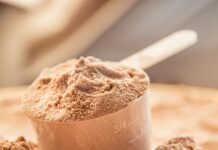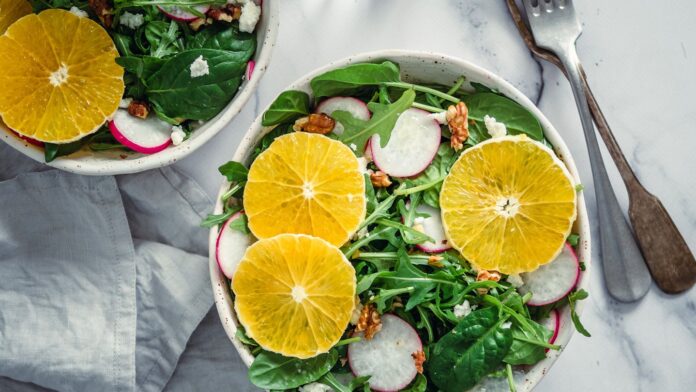Citrus Yogurt for Winter Greek yogurt with citrus and granola topping
Is there anything better than waking up to a bowl of vibrant citrus? Beautiful blood orange slices are combined with Greek yogurt for a protein-rich supper that will keep you satisfied until noon. According to the USDA, a cup of nonfat plain Greek yogurt, which you’ll get from one serving of this dish, has 25.2 grams of protein.
Overall, yogurt is high in probiotic bacteria, which, according to a Cell research published in July 2021, can improve microbiome diversity and reduce inflammation. That’s fantastic news for anyone trying to increase their microbiome’s health, and hence their general health.
Meanwhile, according to Humanities University, blood oranges, like other citrus, provide immune-boosting vitamin C.
Ingredients
2 cups nonfat plain Greek yogurt
1 peeled blood orange, cut into rounds
granola (1/4 cup)
2 tbsp unsalted pepitas or other unsalted nuts or seeds
1/4 cup rinsed fresh blueberries
1 tablespoon honey (optional)
Directions
Separate the yogurt into two serving dishes. Half of the orange slices, granola, pepitas, and blueberries go into each bowl. If desired, drizzle with honey.
Per serving nutrition: 305 calories, 6 grams of total fat (1.3 grams of saturated fat), 30 grams of protein, 32 grams of carbs, 3.4 grams of fiber, 20 grams of sugar (3.5 grams of added sugar), 98 milligrams of sodium.
Juice Jamu (Indonesian Turmeric Drink)
If you don’t already drink jamu juice, you might wish to start. According to a Medium blog post from May 2020, the drink is popular in Indonesia because of its alleged anti-inflammatory, antioxidant, and immune-boosting properties.
True, some of its ingredients are healthy, such as lemons, which contain 18.6 milligrams (mg) of vitamin C per fruit, according to the USDA. As a result, they’re a great supplier of the vitamin.
Other healthful elements in jamu juice include ginger, which has antiviral benefits based on early studies, and turmeric, which has anti-inflammatory and antioxidant qualities based on its active ingredient curcumin, according to an October 2017 article in Foods.
This recipe asks for fresh turmeric, but if you can’t get it, ground turmeric will suffice. However, because ground turmeric has a stronger flavor than fresh turmeric, you may need to alter the amount to achieve the ideal flavor.
It’s not that black pepper is out of place in this dish. According to previous study, the ingredient piperine enhances the amount of curcumin your body can absorb, making black pepper plus turmeric a potent duo.
Ingredients
3/4 cup freshly cleaned and sliced turmeric root (approximately 100 g) (you may leave the skin intact)
1 large piece cleaned and sliced fresh ginger (about 4 inches) (you may leave the skin intact)
4 quarts of water
1 tsp black pepper, freshly ground
2 tablespoons honey
2 lemons, freshly squeezed
Directions
In a blender, combine the turmeric, ginger, water, and pepper. Blend the ingredients on high until it is absolutely smooth.
In a medium saucepan, bring the mixture to a simmer over medium-high heat. Reduce heat to low and continue to cook for another 15 minutes. Remove the mixture from the heat and let it cool somewhat before straining it through a fine-mesh strainer (or cheesecloth). Serve cold, with honey and lemon juice. Because the mixture will naturally split while cooling, gently whisk it before serving.
34 calories per serving, 0 grams total fat (0 grams saturated fat), 0 grams protein, 8 grams carbs, 0 grams fiber, 6.2 grams sugar (5.8 grams added sugar), 1 milligram sodium.
Chicken with Lemon-Garlic
Consider garlic one of your hidden weapons when it comes to immune-boosting cuisine. Garlic’s possible anti-inflammatory, antibacterial, and anticancer capabilities were discussed in a paper published in Medical Hypotheses in November 2020. While additional study is needed, this is encouraging news and another more incentive to eat garlic (besides the fact that it lends dishes a nutty taste).
Garlic and lemon combine to produce a delectable chicken meal in this family-friendly recipe. One thing to keep in mind while preparing vitamin C-rich foods: According to a research published in April 2018 in Food Science and Biotechnology, the nutrient is heat sensitive and would deteriorate when cooked. The lemon juice is added right before serving in this dish to ensure that you get the greatest flavor.
Ingredients
1 tablespoon extra-virgin olive oil
2 lemons, quartered (1 sliced and 1 juiced)
1 head garlic, peeled and divided into cloves
3 thighs of chicken (without sodium solution added during processing)
1/2 teaspoon kosher salt
1/4 teaspoon black pepper, freshly ground
1 tablespoon oregano, chopped
1 teaspoon honey
Directions
Preheat the oven to 425°F. 2 tablespoons olive oil in an oven-safe skillet (preferable cast-iron). Toss in the lemon slices and garlic cloves to coat gently.
Place the chicken thighs skin side up on top of the lemon slices and garlic in the bottom of the skillet. Drizzle the remaining 1 tsp olive oil over the chicken. Place in the preheated oven and season with salt, pepper, and oregano. Bake for 50 to 60 minutes, or until golden brown and a thermometer inserted into the chicken registers 165 degrees F.
In a small dish, combine the lemon juice and honey. Drizzle the lemon mixture over the cooked chicken and serve with the pan drippings and roasted garlic.
401 calories per serving, 28 grams total fat (7 grams saturated fat), 25 grams protein, 10 grams carbs, 0.5 grams fiber, 3.6 grams sugar (2.9 grams added sugar), 388 milligrams sodium.
Salad with Orange and Radish with Citrus Vinaigrette
Salad of spinach, oranges, and walnuts
This vibrant salad is dressed with a citrus vinaigrette and vitamin C-rich oranges (82.7 mg per fruit). According to the USDA, chopped walnuts complete this triad by adding a tasty crunch and a dose of omega-3 fatty acids and zinc to your meal. According to Harvard Health Publishing, omega-3s have been associated to reduced inflammation in the body, which can help the immune system function more efficiently.
Walnuts are also high in polyphenols, an antioxidant, according to a review published in November 2017 in Critical Reviews in Food Science and Nutrition.
A diet rich in polyphenols and zinc (among other good minerals), according to the authors of a review published in the journal Nutrients in June 2020, may be connected to increased immune function and a lower chance of getting COVID-19 and similar disorders.
It’s clear that this salad is not only full of tasty components, but it’s also a great complement to any immune-boosting diet.
Salad Ingredients
6 cups salad greens, mixed
1 peeled orange, cut into rounds
1 finely sliced radish
2 tbsp walnuts, chopped
2 tbsp crumbled goat cheese
Dressing Ingredients:
1 orange, freshly squeezed
2 tablespoons wine vinegar
1 tablespoon mild olive oil
14 teaspoon kosher salt
14 teaspoon black pepper, freshly ground
1 teaspoon honey
Directions
Divide the mixed greens across two serving dishes in an even fashion. Half of the orange slices, radish slices, walnuts, and cheese should be on each plate. Whisk together the dressing ingredients in a small dish. Just before serving, pour over the salad.
Per serving nutrition: 224 calories, 14 grams of total fat (3.2 grams of saturated fat), 6 grams of protein, 21 grams of carbs, 4.4 grams of fiber, 14 grams of sugar (2.9 grams of added sugar), and 211 milligrams of sodium.

















